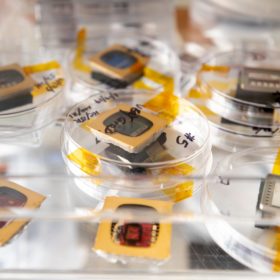
U.S. scientists are trying to understand how non-fullerene small-molecule acceptors (NAFs) increase the efficiency of organic PV devices. They claim that methoxy groups embedded in the acceptors could facilitate an efficiency increase of approximately 6%.
A research group from the Georgia Institute of Technology is trying to gain insight into the morphological properties of non-fullerene small-molecule acceptors (NAFs), which are used in organic PV cells.
How this technology works at the molecular level remains a mystery, the scientists claimed, but getting a clearer picture could help manufacturers to improve the efficiency of their organic PV devices.
The researchers have claimed that small modifications at the molecular level in common NFAs could improve cell performance. “In particular, functional groups introduced at the SMA edges allow the fine tuning of the electronic and morphological properties of the blends,” they said, noting that it is still experimentally difficult to characterize the impact of the precise substitution positions at the molecular scale in a common NFA electron donor/acceptor pairing.
NFA-based donors and acceptors can wrap around each other like “precise swirls of chocolate and vanilla batter in a Bundt cake”, they said. Compared to electron donating and accepting, this wrap-up process provides a better molecular packing in a material.
“Another point is how the acceptor molecules are connected to each other so that the accepted electron has a conductive path to an electrode,” said research author Jean-Luc Brédas. “And it goes for the donors, too.”
The research team said the improved performance did not come from modifications to the metaphorical hand of the acceptor or the donor’s pitching hand, but from something akin to positions of the catcher’s feet, which are a methoxy group located in the acceptor, they explained. In two out of four possible positions, the tiny component increased the efficiency of the tested organic cell from 6% to 12%.
The research’s findings are presented in the paper Organic Solar Cells Based on Non-fullerene Small-Molecule Acceptors: Impact of Substituent Position, published in ScienceDirect.
Researchers at the Ulsan Institute of Science and Technology (UNIST) reached 12.01% efficiency on an organic solar cell (OSC) based on non-fullerene acceptors in September 2018. Two months later, a team of scientists at Friedrich-Alexander Universität Erlangen Nürnberg (FAU), in Germany – working with the South China University of Technology – demonstrated further progress with the technology, achieving a record efficiency of 12.25% for an organic, non-fullerene based single-junction PV cell.
In April 2018, University of Michigan scientists demonstrated an organic solar cell with 15% efficiency. The researchers combined a solution processed non-fullerene-acceptor-based subcell – capable of absorbing near-infra red light of up to 950 nanometers in wavelength, on top of a fullerene-based subcell grown by vacuum thermal evaporation – to absorb visible light from a wavelength of 350 nanometers.
Lắp đặt điện mặt trời Khải Minh Tech
https://ift.tt/2X7bF6x
0906633505
info.khaiminhtech@gmail.com
80/39 Trần Quang Diệu, Phường 14, Quận 3
Lắp đặt điện mặt trời Khải Minh Tech
https://ift.tt/2ZH4TRU
Không có nhận xét nào:
Đăng nhận xét